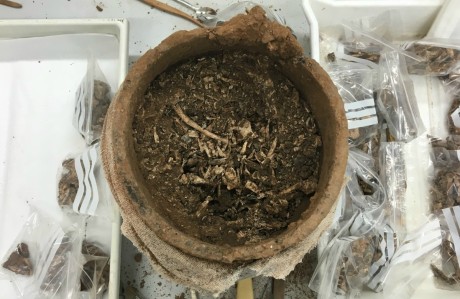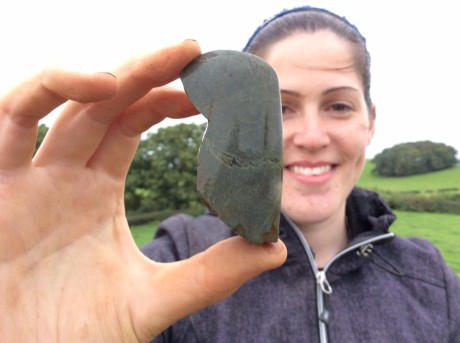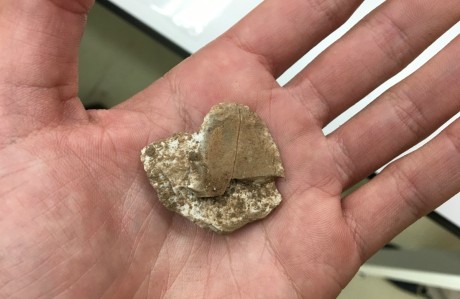
The Morecambe urn is a rare discovery, full to the brim with an unusual quantity of extraordinarily well-preserved human bone. Here’s what we now know about who they belonged to, says osteoarchaeologist Sam Walsh.
The discovery of a Bronze Age burial is a rare occurrence in northwest England. Some researchers have assumed this to be because there wasn’t much happening in the region at the time, and that it was a bit of a Bronze Age blankspot. But was that really the case?
Bronze Age in the northwest
Actually, the relative lack of prehistoric burials found in the region probably isn’t because they never existed, but because fewer people have gone looking for them. The area’s industrial past might be part of the explanation, but there’s also the fact that the burial monuments which have been identified so far (including Whitelow, Astley Hall, Noon Hill, Whitehall and Borwick) tend to be less obvious constructions, like ring-cairns, platform-cairns and other more subtle mounds. Suddenly, it seems that given the right attention, there might be a whole landscape of Bronze Age activity lurking just below the surface, waiting to be discovered.
So you can imagine our excitement when we discovered an early Bronze Age cremation urn buried upside down on top of a hill near Morecambe Bay. And where there’s one, there’s often many. In short, this find could lead to more, and trigger a change in the whole idea that the northwest was a Bronze Age blank spot.
Inside the urn
Back in October, we livestreamed the delicate process of micro-excavating the urn. If you watched the proceedings, you’ll remember that as soon as we opened it up, we found it to be brimming with cremated human bone. At the bottom, we also found a single flint tool and two pottery sherds.
But who did the bones belong, and how many of them were there? More ambitiously, could we use the remains to reconstruct any of the funeral proceedings, like whether they were placed inside in a particular order?
Of course, analysing cremated bone is quite different to analysing bones from a normal burial. Aside from having been burnt, scorched, and generally reduced to much smaller fragments, the remains also been gathered up and placed in a jar, instead of still being neatly laid out in their anatomical position. Going through every fragment of bone, examining each one for tell-tale clues is a painstaking process – you’d be surprised at how much an experienced osteoarchaeologist is able to recognize!

The process starts by delicately putting the remains through a series of sieves in order to sort and weigh the fragments by size, usually 10mm, 5mm, 2mm, and residue. Then, we organise the fragments into areas of the body (legs, pelvis, spine, skull etc) and, wherever possible, identify them to the individual bone. We also look at the colour of the bones, and the fracture patterns, which can give us a range of temperature for the funeral pyre. Finally, we’ll attempt to examine any elements that survive well enough to give us an indication of the individual’s age, sex or health.
Three people, or one incredibly heavy one?
Over the last few weeks, that’s what I’ve been doing. So what have I found?
The first surprising thing about the urn’s contents was the sheer volume of bone inside; nearly three whole kilos! Even when a vessel contains the remains of several people, it’s rare to find an early Bronze Age cremation weighing more than a kilo or two.
Against all our initial expectations, the Morecambe urn did not turn out to contain more than one individual. Instead, the extreme weight of the remains seems to be down to the fact that the bones are extraordinarily well preserved. Even many of the spongy bones (like the pelvis and vertebral bodies), which are usually destroyed on a pyre, have survived in large, identifiable chunks.

Judging by the extent to which the cranial bones had fused together, and by a visible open foramen on some of the tooth roots, the person was clearly young adult, but whether they were male or female is much harder to tell. The skull doesn’t strongly suggest either, and only the mandible and pelvis suggest the individual was slightly more likely to have been a male.
The long bones seem to have been relatively large, but not particularly robust. Likewise, the muscle attachments don’t seem to be heavily developed, all of which adds to the impression of a younger adult.
A healthy young adult?
Overall, they seemed pretty healthy too. The bones didn’t show much sign of any pathological alteration associated with age or disease, although it can be much harder to pick up on cremated remains. The only visible signs was some porosity on fragments of cranium which could be a sign of possible malnutrition, and a little bit of extra bony growth on a few of the phalanges (finger or toe bones).
Finally, the bones themselves were pretty well cremated – they were mostly tan to white in colour, which indicates that the pyre probably reached temperatures of around 600°C. A few small fragments were darker brown or black, which suggests they only reached a temperature of 300°C. This variation is pretty standard for a cremation, as the outskirts of the pyre often reach a lower temperature than the centre.
In summary, the Morecambe urn contains the remains of someone who seems to have been a relatively healthy young adult. After they were cremated, their bones were carefully picked out from the remains of the pyre and placed in the urn, along with a flint tool and some pottery.
These remains are important in both their rarity, their completeness, and the information they can give us about the people of the northwest, all of which can help to build a new and better informed view of Bronze Age Britain.
There is still plenty more we can learn from these extraordinarily well-preserved bones. Were they gathered up in a particular order? Why did they survive so well? And will additional scientific analysis reveal more about the person, like where they were from?
I’m looking forward to seeing what else the study of this precious urn and its contents will reveal, and to returning to Lancashire this summer to see if DigVentures’ excavations can help reveal the truth about Bronze Age life in the northwest.


